Transcription of A National Principal Survey on How Social and Emotional ...
1 A National Principal Survey on How Social and Emotional Learning Can Prepare Children and Transform Schools Civic Enterprises with Hart Research AssociatesA Report for CASELBy Jennifer L. DePaoli, Matthew N. Atwell, and John BridgelandReady to LeadA National Principal Survey on How Social and Emotional Learning Can Prepare Children and Transform Schools A Report for CASELBy Jennifer L. DePaoli, Matthew N. Atwell, and John BridgelandCivic Enterprises with Hart Research AssociatesCollaborative for Academic, Social , and Emotional Learning (CASEL) is the nation s leading organization advancing and promoting integrated Pre-K to 12 academic, Social , and Emotional learning for all students. Our mission is to make Social and Emotional learning an integral part of education from preschool through high school. Through research, practice, and policy, CASEL collaborates to ensure all students become knowledgeable, responsible, caring, and contributing members of society.
2 Learn more about our work at Enterprises is a Social enterprise firm that works with corporations, nonprofits, foundations, universities and governments to develop innovative initiatives and public policies in the fields of education, National service, civic engagement, conservation, public health and more. We work with organizations that seek to challenge the status quo and grow their impact for the greater good. Working closely with clients to determine what they need to better engage with their stakeholders and serve their constituents, we specialize in research and policy development, strategy and coali-tion building, state and federal policy analysis, and strategic communications. For more information about Civic Enterprises, please visit their website at Hart Research Associates is one of the leading research firms in the United States and has been at the cutting edge of change in public opinion since our founding in 1971.
3 During that time, we have conducted more than 8,000 public opinion surveys and 7,500 focus groups and in-depth interviews, talking with more than five million individuals across the United States and beyond. In addition to conducting research among everyday Americans, voters, and consumers, we routinely interview elite audiences. These include C-suite decision-makers, senior government officials, and thought leaders across a full range of disciplines, both nationally and abroad. For more information about Hart Research, please visit their website at Table of ContentsOpen Letter ..1 Executive Summary ..2 Introduction ..8 What is Social and Emotional Learning? ..11 Survey Findings 1: Attitudes about SEL ..13 Snapshot: Anchorage School District Building on Grassroots SEL ..17 Survey Findings 2: SEL Implementation ..19 Snapshot: Metropolitan Nashville Public Schools Meeting Schools Where They Are to Advance SEL.
4 27 Survey Findings 3: The Path to Increased SEL ..28 Snapshot: Austin Independent School District Providing Proof to Get Results ..31 Survey Findings 4: Assessing SEL ..32 Snapshot: Washoe County School District Factoring SEL into Student Success ..39 Key Findings and Recommendations ..41 Conclusion ..45 Acknowledgements ..46 Appendix I: Methodology ..47 Appendix II: Findings from The Missing Piece: A National Teacher Survey on How Social and Emotional Learning Can Empower Children and Transform Schools ..48 Appendix III: CASEL s Collaborating Districts Initiative ..49 Appendix IV: Additional Graphs and Tables ..50 References ..51 Ready to Lead | 1 Open Letter to the American PeopleThe idea of integrating the Social , Emotional , and academic dimensions of learning and the promise of improving our children s outcomes and unleashing the power of schools and communities as spaces that nurture their full development has galvanized the educational community s interest with an enthusiasm rarely seen in the history of American education.
5 It is our hope, as the Co-Chairs of the Aspen Institute s National Commission on Social , Emotional and Academic Development, that this report will help America better understand how Social and Emotional development serves as a foundation for student learning. We also hope to connect readers to the perspectives of principals and administrators who engage in the day-to-day rewarding and challenging work of educating our from the breakthrough report, The Missing Piece, which captured the voice of teachers across America, Civic Enterprises has now turned to principals and other administrators for their insights. In short, these pioneering school leaders of today are strongly focused on a missing piece of American education: how to support the Social and Emotional development of their students. Educators know that Social and Emotional development improves student behavior, classroom management, school climate, and even student health.
6 They also know that Social and Emotional learning improves grades and standardized test scores, boosts graduation rates and postsecondary completion rates, and leads to better employment outcomes. Given these measurable benefits, there is great urgency to integrate Social and Emotional learning frameworks. This report illustrates the motivation behind these school leaders commitment: they realize that developing the whole student is the key to creating schools that are safe and challenging; is fundamental to shaping students who are supported and inspired; is critical to ensuring that teachers can be effective and fulfilled; and is the foundation of communities where citizenship, purpose, employment, and stability are possible for every child. This report tells another story, too: although interest in Social and Emotional learning is overwhelmingly high, principals and administrators are hungry for the expertise necessary to adopt new strategies.
7 In some ways, there is a tension in the data: while the vast majority of leaders believe that Social and Emotional development is essential to education, the pathway to change is not always clear; moreover, the time and training to make the necessary changes are in short supply. These experts tell us that there is a lot of will, but not as much clarity and support, along the believe, as our fellow Co-Chair Linda Darling-Hammond wrote, that the survival of the human race depends at least as much on the cultivation of Social and Emotional intelligence as it does on the development of technical knowledge and skills. We can and should integrate academic learning with the Social , Emotional and cognitive dimensions of healthy human development, as well as retain high standards for all our children. As the following report so compellingly illustrates, our school leaders advise that we have no time to waste. Dr.
8 Timothy P. ShriverCo-ChairGovernor John EnglerCo-ChairDr. Linda Darling HammondCo-Chair2 | Ready to LeadThe central message of this report is that principals across the United States understand how fundamen-tal Social and Emotional learning (SEL) is to the development of students and their success in and out of school, but they need more guidance, training, and support to make solid and effective school-wide implementation a reality. Principals understand that SEL competencies are teachable, believe they should be developed in all students, and know that young people equipped with SEL skills will become better students now and better adults in the future. In today s environment of increasingly demanding jobs and the fraying of American communities, nothing could be more important than to foster, teach, and promote the competencies of self-awareness, self-management, Social awareness, relationship skills, and responsible decision-making.
9 Some call it empathy, discipline, character, collaborative problem solving, or other names but regardless of the name, they are the attitudes and skills that provide the glue of a functioning society, robust economy, and vibrant democracy. Most principals see how SEL boosts student academic achievement, but they want more evidence of those impacts to strengthen the case for action. Although support among principals for embedding SEL in the cul-ture and classrooms of schools is high, implementation varies widely across schools with about one in three principals implementing it school-wide, and only one in four meeting benchmarks for high-quality implemen-tation. Encouragingly, when principals and teachers attempting to implement SEL are well supported by their district leadership, they have better outcomes, and when state policymakers back district leaders, the results are even more pronounced. These and other findings come from a nationally representative Survey of 884 Pre-K to 12 public school principals and interviews with 16 superintendents and 10 district-level research and evaluation specialists representing diverse school districts and with varying levels of experience in implementing SEL programming.
10 Despite representing different grade spans, student populations, and geographic areas, the administrators in this report see the potential in Social and Emotional learning and provide key insights into the factors that can either slow SEL implementation at the school and district levels or help it grow and flourish. This strong support for SEL among our nation s principals builds on similar levels of support from teachers across the United States, as reported in the 2013 report, The Missing Piece. While our educational leaders and practitioners see the value of SEL, they need support, resources, and tools to help them fully implement systemic SEL initiatives that can improve students SEL knowledge, skills, and attitudes, as well as their college, career, and life readiness. Executive SummaryReady to Lead | 3 Survey FindingsFindings from the Principal Survey are presented in four major areas: (1) Attitudes about SEL, (2) SEL implementation, (3) The path to increased SEL, and (4) Assessing SEL.
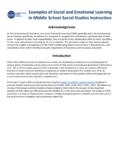

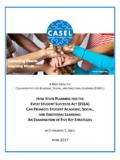

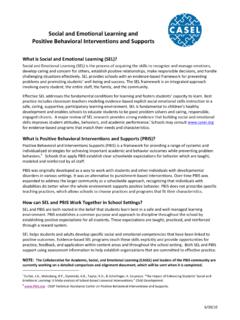
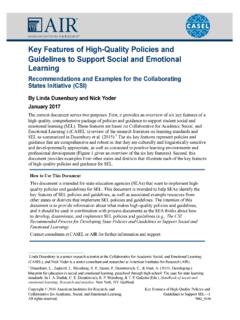



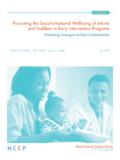
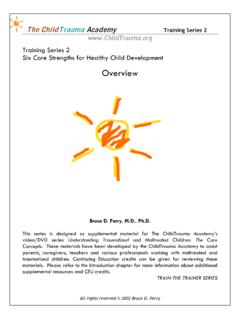

![Social and Emotional Goals and Transition [Read-Only]](/cache/preview/e/d/1/f/3/3/a/4/thumb-ed1f33a412a1f616c962511614e95205.jpg)